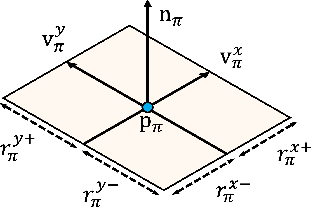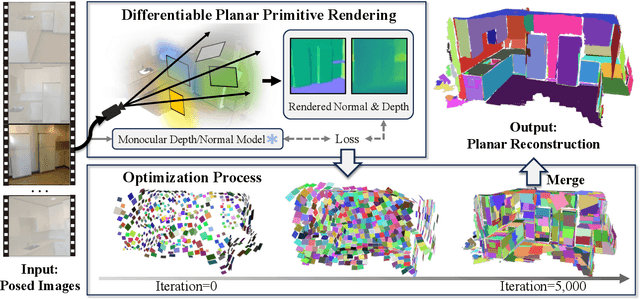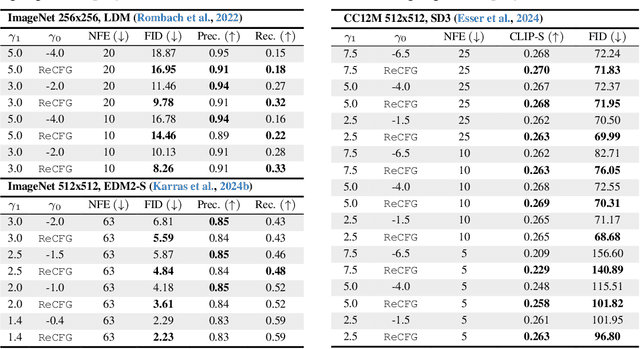Nan Xue
UCD: Unconditional Discriminator Promotes Nash Equilibrium in GANs
Oct 01, 2025Abstract:Adversarial training turns out to be the key to one-step generation, especially for Generative Adversarial Network (GAN) and diffusion model distillation. Yet in practice, GAN training hardly converges properly and struggles in mode collapse. In this work, we quantitatively analyze the extent of Nash equilibrium in GAN training, and conclude that redundant shortcuts by inputting condition in $D$ disables meaningful knowledge extraction. We thereby propose to employ an unconditional discriminator (UCD), in which $D$ is enforced to extract more comprehensive and robust features with no condition injection. In this way, $D$ is able to leverage better knowledge to supervise $G$, which promotes Nash equilibrium in GAN literature. Theoretical guarantee on compatibility with vanilla GAN theory indicates that UCD can be implemented in a plug-in manner. Extensive experiments confirm the significant performance improvements with high efficiency. For instance, we achieved \textbf{1.47 FID} on the ImageNet-64 dataset, surpassing StyleGAN-XL and several state-of-the-art one-step diffusion models. The code will be made publicly available.
SpatialTrackerV2: 3D Point Tracking Made Easy
Jul 16, 2025Abstract:We present SpatialTrackerV2, a feed-forward 3D point tracking method for monocular videos. Going beyond modular pipelines built on off-the-shelf components for 3D tracking, our approach unifies the intrinsic connections between point tracking, monocular depth, and camera pose estimation into a high-performing and feedforward 3D point tracker. It decomposes world-space 3D motion into scene geometry, camera ego-motion, and pixel-wise object motion, with a fully differentiable and end-to-end architecture, allowing scalable training across a wide range of datasets, including synthetic sequences, posed RGB-D videos, and unlabeled in-the-wild footage. By learning geometry and motion jointly from such heterogeneous data, SpatialTrackerV2 outperforms existing 3D tracking methods by 30%, and matches the accuracy of leading dynamic 3D reconstruction approaches while running 50$\times$ faster.
ScaleLSD: Scalable Deep Line Segment Detection Streamlined
Jun 11, 2025Abstract:This paper studies the problem of Line Segment Detection (LSD) for the characterization of line geometry in images, with the aim of learning a domain-agnostic robust LSD model that works well for any natural images. With the focus of scalable self-supervised learning of LSD, we revisit and streamline the fundamental designs of (deep and non-deep) LSD approaches to have a high-performing and efficient LSD learner, dubbed as ScaleLSD, for the curation of line geometry at scale from over 10M unlabeled real-world images. Our ScaleLSD works very well to detect much more number of line segments from any natural images even than the pioneered non-deep LSD approach, having a more complete and accurate geometric characterization of images using line segments. Experimentally, our proposed ScaleLSD is comprehensively testified under zero-shot protocols in detection performance, single-view 3D geometry estimation, two-view line segment matching, and multiview 3D line mapping, all with excellent performance obtained. Based on the thorough evaluation, our ScaleLSD is observed to be the first deep approach that outperforms the pioneered non-deep LSD in all aspects we have tested, significantly expanding and reinforcing the versatility of the line geometry of images. Code and Models are available at https://github.com/ant-research/scalelsd
Equivariant Flow Matching for Point Cloud Assembly
May 24, 2025Abstract:The goal of point cloud assembly is to reconstruct a complete 3D shape by aligning multiple point cloud pieces. This work presents a novel equivariant solver for assembly tasks based on flow matching models. We first theoretically show that the key to learning equivariant distributions via flow matching is to learn related vector fields. Based on this result, we propose an assembly model, called equivariant diffusion assembly (Eda), which learns related vector fields conditioned on the input pieces. We further construct an equivariant path for Eda, which guarantees high data efficiency of the training process. Our numerical results show that Eda is highly competitive on practical datasets, and it can even handle the challenging situation where the input pieces are non-overlapped.
Seeing through Satellite Images at Street Views
May 22, 2025Abstract:This paper studies the task of SatStreet-view synthesis, which aims to render photorealistic street-view panorama images and videos given any satellite image and specified camera positions or trajectories. We formulate to learn neural radiance field from paired images captured from satellite and street viewpoints, which comes to be a challenging learning problem due to the sparse-view natural and the extremely-large viewpoint changes between satellite and street-view images. We tackle the challenges based on a task-specific observation that street-view specific elements, including the sky and illumination effects are only visible in street-view panoramas, and present a novel approach Sat2Density++ to accomplish the goal of photo-realistic street-view panoramas rendering by modeling these street-view specific in neural networks. In the experiments, our method is testified on both urban and suburban scene datasets, demonstrating that Sat2Density++ is capable of rendering photorealistic street-view panoramas that are consistent across multiple views and faithful to the satellite image.
FLARE: Feed-forward Geometry, Appearance and Camera Estimation from Uncalibrated Sparse Views
Feb 19, 2025Abstract:We present FLARE, a feed-forward model designed to infer high-quality camera poses and 3D geometry from uncalibrated sparse-view images (i.e., as few as 2-8 inputs), which is a challenging yet practical setting in real-world applications. Our solution features a cascaded learning paradigm with camera pose serving as the critical bridge, recognizing its essential role in mapping 3D structures onto 2D image planes. Concretely, FLARE starts with camera pose estimation, whose results condition the subsequent learning of geometric structure and appearance, optimized through the objectives of geometry reconstruction and novel-view synthesis. Utilizing large-scale public datasets for training, our method delivers state-of-the-art performance in the tasks of pose estimation, geometry reconstruction, and novel view synthesis, while maintaining the inference efficiency (i.e., less than 0.5 seconds). The project page and code can be found at: https://zhanghe3z.github.io/FLARE/
PlanarSplatting: Accurate Planar Surface Reconstruction in 3 Minutes
Dec 04, 2024



Abstract:This paper presents PlanarSplatting, an ultra-fast and accurate surface reconstruction approach for multiview indoor images. We take the 3D planes as the main objective due to their compactness and structural expressiveness in indoor scenes, and develop an explicit optimization framework that learns to fit the expected surface of indoor scenes by splatting the 3D planes into 2.5D depth and normal maps. As our PlanarSplatting operates directly on the 3D plane primitives, it eliminates the dependencies on 2D/3D plane detection and plane matching and tracking for planar surface reconstruction. Furthermore, the essential merits of plane-based representation plus CUDA-based implementation of planar splatting functions, PlanarSplatting reconstructs an indoor scene in 3 minutes while having significantly better geometric accuracy. Thanks to our ultra-fast reconstruction speed, the largest quantitative evaluation on the ScanNet and ScanNet++ datasets over hundreds of scenes clearly demonstrated the advantages of our method. We believe that our accurate and ultrafast planar surface reconstruction method will be applied in the structured data curation for surface reconstruction in the future. The code of our CUDA implementation will be publicly available. Project page: https://icetttb.github.io/PlanarSplatting/
WDMoE: Wireless Distributed Mixture of Experts for Large Language Models
Nov 11, 2024



Abstract:Large Language Models (LLMs) have achieved significant success in various natural language processing tasks, but the role of wireless networks in supporting LLMs has not been thoroughly explored. In this paper, we propose a wireless distributed Mixture of Experts (WDMoE) architecture to enable collaborative deployment of LLMs across edge servers at the base station (BS) and mobile devices in wireless networks. Specifically, we decompose the MoE layer in LLMs by placing the gating network and the preceding neural network layer at BS, while distributing the expert networks among the devices. This deployment leverages the parallel inference capabilities of expert networks on mobile devices, effectively utilizing the limited computing and caching resources of these devices. Accordingly, we develop a performance metric for WDMoE-based LLMs, which accounts for both model capability and latency. To minimize the latency while maintaining accuracy, we jointly optimize expert selection and bandwidth allocation based on the performance metric. Moreover, we build a hardware testbed using NVIDIA Jetson kits to validate the effectiveness of WDMoE. Both theoretical simulations and practical hardware experiments demonstrate that the proposed method can significantly reduce the latency without compromising LLM performance.
Rectified Diffusion Guidance for Conditional Generation
Oct 24, 2024



Abstract:Classifier-Free Guidance (CFG), which combines the conditional and unconditional score functions with two coefficients summing to one, serves as a practical technique for diffusion model sampling. Theoretically, however, denoising with CFG cannot be expressed as a reciprocal diffusion process, which may consequently leave some hidden risks during use. In this work, we revisit the theory behind CFG and rigorously confirm that the improper configuration of the combination coefficients (i.e., the widely used summing-to-one version) brings about expectation shift of the generative distribution. To rectify this issue, we propose ReCFG with a relaxation on the guidance coefficients such that denoising with ReCFG strictly aligns with the diffusion theory. We further show that our approach enjoys a closed-form solution given the guidance strength. That way, the rectified coefficients can be readily pre-computed via traversing the observed data, leaving the sampling speed barely affected. Empirical evidence on real-world data demonstrate the compatibility of our post-hoc design with existing state-of-the-art diffusion models, including both class-conditioned ones (e.g., EDM2 on ImageNet) and text-conditioned ones (e.g., SD3 on CC12M), without any retraining. We will open-source the code to facilitate further research.
Partial Distribution Matching via Partial Wasserstein Adversarial Networks
Sep 16, 2024



Abstract:This paper studies the problem of distribution matching (DM), which is a fundamental machine learning problem seeking to robustly align two probability distributions. Our approach is established on a relaxed formulation, called partial distribution matching (PDM), which seeks to match a fraction of the distributions instead of matching them completely. We theoretically derive the Kantorovich-Rubinstein duality for the partial Wasserstain-1 (PW) discrepancy, and develop a partial Wasserstein adversarial network (PWAN) that efficiently approximates the PW discrepancy based on this dual form. Partial matching can then be achieved by optimizing the network using gradient descent. Two practical tasks, point set registration and partial domain adaptation are investigated, where the goals are to partially match distributions in 3D space and high-dimensional feature space respectively. The experiment results confirm that the proposed PWAN effectively produces highly robust matching results, performing better or on par with the state-of-the-art methods.
 Add to Chrome
Add to Chrome Add to Firefox
Add to Firefox Add to Edge
Add to Edge